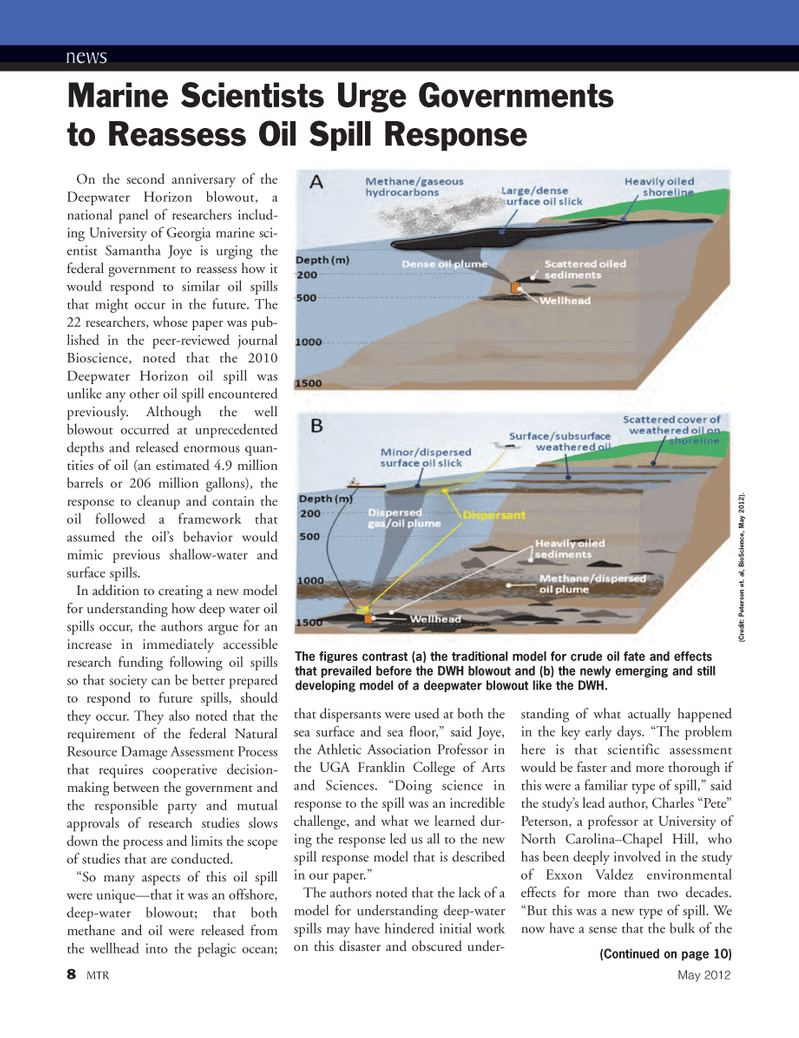
Page 8: of Marine Technology Magazine (May 2012)
Hydrographic Survey
Read this page in Pdf, Flash or Html5 edition of May 2012 Marine Technology Magazine
news On the second anniversary of the Deepwater Horizon blowout, a national panel of researchers includ- ing University of Georgia marine sci- entist Samantha Joye is urging the federal government to reassess how it would respond to similar oil spills that might occur in the future. The 22 researchers, whose paper was pub- lished in the peer-reviewed journal Bioscience, noted that the 2010 Deepwater Horizon oil spill was unlike any other oil spill encountered previously. Although the well blowout occurred at unprecedented depths and released enormous quan- tities of oil (an estimated 4.9 millionbarrels or 206 million gallons), the response to cleanup and contain the oil followed a framework that assumed the oil?s behavior would mimic previous shallow-water and surface spills. In addition to creating a new model for understanding how deep water oil spills occur, the authors argue for an increase in immediately accessible research funding following oil spills so that society can be better prepared to respond to future spills, should they occur. They also noted that the requirement of the federal Natural Resource Damage Assessment Process that requires cooperative decision- making between the government and the responsible party and mutual approvals of research studies slows down the process and limits the scope of studies that are conducted. ?So many aspects of this oil spill were unique?that it was an offshore, deep-water blowout; that both methane and oil were released from the wellhead into the pelagic ocean; that dispersants were used at both the sea surface and sea floor,? said Joye, the Athletic Association Professor in the UGA Franklin College of Arts and Sciences. ?Doing science in response to the spill was an incredible challenge, and what we learned dur- ing the response led us all to the new spill response model that is described in our paper.? The authors noted that the lack of amodel for understanding deep-waterspills may have hindered initial work on this disaster and obscured under- standing of what actually happenedin the key early days. ?The problem here is that scientific assessment would be faster and more thorough if this were a familiar type of spill,? said the study?s lead author, Charles ?Pete? Peterson, a professor at University of North Carolina?Chapel Hill, who has been deeply involved in the study of Exxon Valdez environmental effects for more than two decades. ?But this was a new type of spill. We now have a sense that the bulk of the Marine Scientists Urge Governments to Reassess Oil Spill Response (Credit: Peterson et. al, BioScience, May 2012). The figures contrast (a) the traditional model for crude oil fate and effects that prevailed before the DWH blowout and (b) the newly emerging and still developing model of a deepwater blowout like the DWH. (Continued on page 10)8MTRMay 2012MTR#4 (1-17):MTR Layouts 5/7/2012 9:22 AM Page 8

 7
7

 9
9
